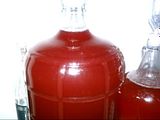In 5th day of primary and she's stinky - sulphury smell. I checked SG and show 1.055. I'm worried.
Announcement
Collapse
No announcement yet.
dried cranberry
Collapse
X
-
sulphury...
Stir, stir, stir Jojo! After stirring, rack it and splash it around like crazy. If you have a clean and sanitized copper pipe, stir it with that! Top up as much as possible after the racking. I know it is hard to top up very much with SG still that high after racking, but the racking and stirring will have it outgassing like mad and hopefully it will carry the sulphur with it. Get busy!
 REBEL MODERATOR
REBEL MODERATOR

...lay down the boogie and play that funky music 'til ya die...'til ya die !"
-
copper...
I am not sure of the exact terms, but some kind of chemical reaction takes place and the copper dissipates the sulphur. Hopefully Pat will see this and explain further. It just takes about a minute of stirring with the copper, then wait and do the splash racking and stirring with your paddle or spoon and give it a few days to see if you need to use the copper pipe again. The excess sulphur shouldn't keep the wine from fermenting to dryness. Use a different yeast strain next time on that particular type wine. Which strain is it?
 REBEL MODERATOR
REBEL MODERATOR

...lay down the boogie and play that funky music 'til ya die...'til ya die !"
Comment
-
I followed Jack Kellers recipe and used RC212. Not very much foam this time around. I think it worked. It looks much normal this morning. I racked it off into a 3 gallon carboy and 1 gallon jug after beating it with the pipe. The splashing tired me out!Originally posted by HippieI am not sure of the exact terms, but some kind of chemical reaction takes place and the copper dissipates the sulphur. Hopefully Pat will see this and explain further. It just takes about a minute of stirring with the copper, then wait and do the splash racking and stirring with your paddle or spoon and give it a few days to see if you need to use the copper pipe again. The excess sulphur shouldn't keep the wine from fermenting to dryness. Use a different yeast strain next time on that particular type wine. Which strain is it?

Comment
-
Good job!
Jojo, if I remember correctly, RC212 is one of those yeasts prone to producing alot of sulphur. Sometimes it can just be a combination of certain strains with certain fermentables. Also, it might just be a product of fermenting with not enough nutrient or nitrogen to support health.
Dontcha just love the perpetual learning from this hobby?
 REBEL MODERATOR
REBEL MODERATOR

...lay down the boogie and play that funky music 'til ya die...'til ya die !"
Comment
-
Thanks Hippie!
I did some reading on RC212 and you're right. It's on day 10 of primary now and still bubbling strong, but SG has only gone down a little bit (1.040). Not sure, but it looks like sulphur is building up just above the top of the must. There are white rings forming I've never seen before.
From the way it is going this looks to be the longest primary ferment I've seen. The stirring and splashing take the smell away, but a few days later and it comes back. I take it later in the process when things die down the smell will settle out?
I did introduce yeast energizer at the start.
Comment
-
From Lallemands' website:
"RC212: For Pinot noir with color and structure
RC212 was selected from fermentations in Burgundy by the BIVB. It requires high nutrient additions to avoid the potential development of H2S and demonstrates best results when rehydrated with GO-FERM. RC212 consistently produces Pinot noirs with good structure, ripe berry, bright fruit and spicy characteristics. Wines made with RC212 can be blended with wines made with RA17 to achieve more complexity and finesse."
You may wish to add some nutrient now. And get the temperature up to around 75 degrees F. RC212 is a slow fermenter at low temperatures, and can stall out without restarting on its' own. If you have no access to "yeast nutrient", you can pick up some "Brewers yeast" tablets from the phamacy or health foods store. Grind up one tablet per US gallon of must, add enough water to dissolve, and add this to your must.
In future, you may wish to look at using 71B-1122 for fermenting your fruit wines.
" 71B: For nouveau wines
71B was isolated by the INRA (National Agricultural Research Institute) in Narbonne, France. 71B is known for making blush and semi-sweet wines with a 'fruit salad' character. Long-lived aromas are due to its production of esters and higher alcohols. 71B also softens high acid musts by partially metabolizing malic acid."
Check out this site for more information on H2S and its' der4ivatives, and pointers on treatment.
Good luck with this wine.
Pat
Comment
-
acid...
You can add some tartaric now, about 1 tsp per gallon. When the fermentation is done, add a 50/50 mixture of tartaric and citric until you get it where you want it. Cranberry main acid is citric, but usually does not survive fermentation, tartaric will.
 REBEL MODERATOR
REBEL MODERATOR

...lay down the boogie and play that funky music 'til ya die...'til ya die !"
Comment


Comment